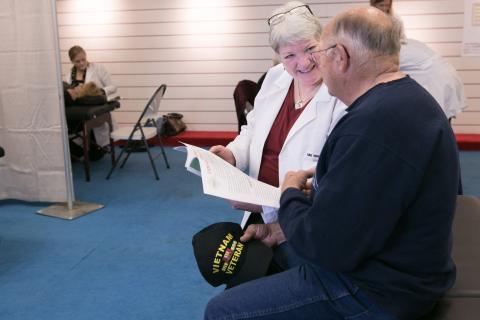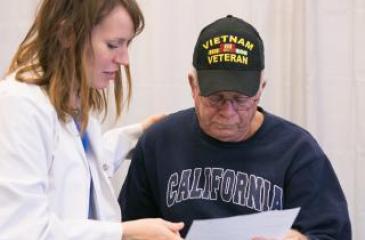The clinical data repository managed by the Clinical and Translational Science Institute (CTSI) Informatics Consulting Service (ICS) houses the electronic health records of more than 2.3 million patients for research purposes.
The data repository was established between the University of Minnesota, Academic Health Center, and Fairview Health Services in 2013. The goal of the data repository is to protect patient privacy, while giving scientists at the University of Minnesota and Fairview Health Services access to data that’s critical to advancing health research.
CTSI’s Informatics Consulting Service can help an investigator at two points in the process: first, to estimate the number of patients available for a study. Once the study has begun, the study team can then work with CTSI and Fairview to identify promising eligible patients and mail invitations asking patients to consider participating. This CTSI-led approach gives health researchers a team of experts to assist in the difficult task of recruiting study participants.
Hitting enrollment goals
“CTSI helped us consistently meet our participant recruitment goals, and achieve our best-ever results,” says Rebecca Brown, MSN, MS, RN, a clinical research coordinator with the School of Nursing who supports studies that aim to help people with vascular diseases. “When we’ve partnered with CTSI to create a recruitment mailing list, we have had cases where our phones ring non-stop with callers interested in joining our study. One of our studies even doubled enrollment, virtually overnight.”
Brown credits CTSI’s Informatics Consulting Service with enabling them to hit their recruitment goals when they otherwise may not have, had they exclusively relied on traditional forms of recruitment.
For example, to attract participants to a study that aimed to see if a fitness monitoring band could help people maintain exercise levels after cardiac rehabilitation, they partnered with local cardiac rehab facilities. But given the specific inclusion and exclusion criteria of the study, it was difficult to identify sufficient numbers of patients with this method alone. After one year, only a handful of volunteers enrolled.
Finding the appropriate potential participants
With the enrollment deadline looming, the study team brought in CTSI’s Informatics Consulting Service to help find the most potentially eligible patients from more than 2 million patients in Fairview’s electronic health record (EHR).
There are formal processes that dictate who can access the data and for what purposes, to protect patient’s privacy and health information. For example, each research study that wishes to use the repository must be approved by the University’s Institutional Review Board, which reviews the study for patient safety and privacy and compliance with Federal laws and regulations. The CTSI Informatics Consulting Service partners with Fairview Research Administration, working with the research team to meet their recruitment mailing needs.

The CTSI team uses informatics methods to extract key data from the clinical data repository that meet the study inclusion and exclusion criteria. For Brown, the resulting data was presented as a grid that made it easy for her to get a quick snapshot of the patient and decide who met the study’s requirements. Brown could view each patient’s demographic information, relevant medical history, and details about clinic visits such as diagnoses, procedures, medications, lab tests, visit location, and provider specialty.
While Brown needed the data to recruit study volunteers, researchers can also request information from the clinical data repository to study medical conditions, analyze patient outcomes, and pinpoint best practices across large populations and/or from clinic to clinic.
Doubling enrollment
After reviewing the data, Brown and CTSI could then partner with Fairview to mail the invitations. The patient contact information was not known to Brown; letters were mailed by Fairview research administration staff, who act as intermediary between patients and the study staff.
A relatively small batch of letters – 140 total – spurred 18 participants to join the study, more than doubling their enrollment roster.
Plus, six more patients would have joined had the time period for enrolling participants been been longer. They would have become eligible upon completing cardiac rehab, but their completion date didn’t fall within the study’s enrollment timeframe.
“CTSI helped us dramatically increase our enrollment rates,” said Brown. “While we previously would expect to enroll less than 1 percent of people who received our mailer, we now see enrollment rates in the neighborhood of 12-15 percent. Teaming up with CTSI has become our go-to method for recruiting study participants.”
Collaborating with CTSI
Getting the mailer in motion was a relatively simple and highly collaborative process, according to Brown.
To start, she requested the clinical data by completing an online form to describe her team’s research goal, inclusion criteria, exclusion criteria, and specific health record codes (e.g., International Classification of Diseases codes such as ICD-9 or ICD-10).
Then, to Brown’s delight, a CTSI Informatics Consulting Service consultant, Kathleen McKay, PhD, sat down with her one-on-one to get a firmer understanding of what the study team needed.
“CTSI listens to what we’re looking for, and uses those insights to deliver astonishing results,” says Brown. “We’ve been successful because we combine our knowledge of the exact individuals we’re looking for with Informatics knowledge on how to find these individuals in a massive data repository.”
The peripheral artery disease (PAD) research that Brown and team conduct exemplify the importance of thoroughly understanding electronic health records. For years, Brown and team had requested patients under a specific ICD-9 code. CTSI's informatics team discovered there were variations in coding for these patients -- which in effect “hid” these patients from Brown and team -- and found a better way to identify the right patients.
“Knowing exactly how providers use thousands of health codes wasn’t something we could have ever known on our own,” says Brown. “Because CTSI has such in-depth knowledge of how complex information is being entered into the health record, they helped us find what we needed and turn things around so we could hit our goal.”

Getting creative with data searches
One of the challenges with trying to find something in electronic health records is that it isn’t always instinctive. What sounds intuitive to a clinician isn’t necessarily the way information is entered into the health record.
For example, peripheral artery disease (PAD) is charted differently than more commonly charted diseases like coronary artery disease. On top of this, PAD often goes undiagnosed - a troubling fact since these individuals are at significantly increased risk of heart attack or stroke.
So when Brown and team searched the standard ICD code for patients with PAD, it didn’t yield the individuals they were expecting.
CTSI’s Informatics Consulting Service then developed a creative way for finding people with peripheral artery disease in a sea of data.
Rather than searching for, say, anyone’s who’s had a PAD diagnosis, CTSI’s informatics team searched for patients who saw an interventional radiologist or vascular specialist at least twice in the last year. This more strongly suggested these individuals indeed had peripheral artery disease, and it truly was a problem for them.
This and other strategies deployed by CTSI’s informatics team whittled an initial query yielding 10,000 individuals down to a few hundred.
Pursuing a respectful recruitment approach
The CTSI process also weeded out people who had other serious conditions – say, cancer – thinking they may have other health concerns that are taking priority.
“I feel better knowing we have a way to contact the most eligible patients, and that we are hopefully less of a burden to those who may be less likely to qualify for the study,” says Brown. “These are the very people we’re trying to help, so conducting research in a way that’s respectful, ethical, and appropriate is important to us.”

Streamlining their approach
Having a concentrated list of truly qualified candidates also saves time and money for research teams, so they spend less time attracting and screening patients and more time actually doing research.
“It’s remarkable to have so many people call us because they’re interested in our studies,” says Brown. “But what’s truly revolutionary about CTSI’s data culling process is how the vast majority of interested participants meet our eligibility criteria, greatly improving our odds for a successful study.”
The percentage of interested participants who qualified for one of the studies Brown supports soared from 10 percent to more than 70 percent.
And Brown doesn’t think that increased rate even does justice. Had the study been able to enroll for a few more months, they could have enrolled 96 percent of the participants who called after receiving the mailer.
With each phone screening taking anywhere from 10 to 30 minutes and some studies calling for additional in-person screening, the time savings are tremendous.
For example, before partnering with CTSI’s informatics team, Brown and team once screened 1,200 patients for a study, to discover only 200 actually had peripheral artery disease and would qualify for the study.
“Now that we can better identify the people who are most likely to participate in our studies, we’ve significantly streamlined our overall process,” says Brown. “We send fewer mailers, spend less time screening, and ultimately reduce the overall effort spent trying to recruit people who are unlikely to join our studies.”
Continuing enhancements
In addition to helping researchers find potential participants, CTSI’s Informatics Consulting Service also offers monthly workshops and training sessions to help researchers leverage clinical data for their research.
Brown was so inspired by the educational aspect – delivered both via these educational activities and throughout the collaborative data request process – that she decided to steer her own educational ambitions in that direction. This fall, she’ll begin a nursing PhD program at the University of Minnesota, and intends to pursue a minor in informatics.
The educational aspect isn’t just for researchers; it’s a two-way street, as Brown explains:
“Every time we request data, we learn more about how to ask for data and CTSI becomes more familiar with what we’re looking for. We’ve had slam dunks with some projects and with the others, we've learned so much about how the data exists in the electronic health record and are continuing to refine our strategy.”
Positioning their research for future success
With several recruitment successes under their belt, Brown and team are now leveraging their results on a national level.
They include this CTSI-supported recruitment method in grant and institutional review board (IRB) applications to show they can successfully and respectfully attract study participants. Their proven track record and PI Dr. Diane Treat-Jacobson's long standing reputation in PAD research even piqued the interest of another university that invited Dr. Treat-Jacobson, Brown, and Coordinator Mary Whipple to become a site for a Patient-Centered Outcomes Research Institute (PCORI) grant.
“Many other institutions don’t offer researchers access to such clinical data, so when they learn of CTSI’s informatics services and our concrete results, they’re so impressed,” explains Brown. “We instill confidence in our research and the University as a whole because of the respectful and efficient way we recruit study participants.”
Brown and team’s ability to surmount one of research’s biggest hurdles promises to open even more doors down the road, as she explains:
“Similar to virtually all researchers, finding appropriate participants to join our studies was one of our biggest challenges. Yet, CTSI helps us to achieve our recruitment goals. Now that we have an efficient, tried-and-true way to find willing study volunteers, we can keep advancing research that aims to help people with vascular diseases live longer, healthier lives.”
Please note that results will vary from researcher to researcher.
